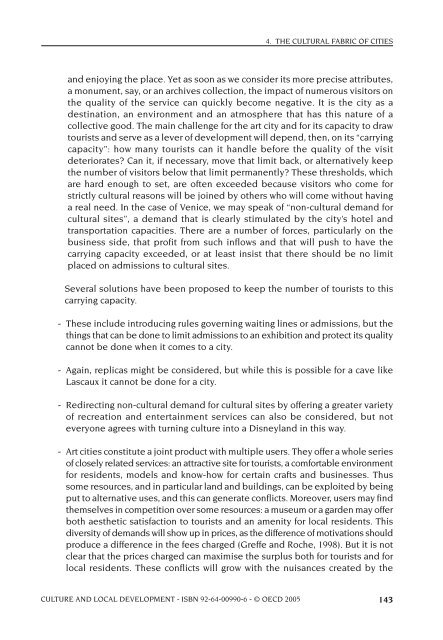OECD Culture and Local Development.pdf - PACA
OECD Culture and Local Development.pdf - PACA
OECD Culture and Local Development.pdf - PACA
You also want an ePaper? Increase the reach of your titles
YUMPU automatically turns print PDFs into web optimized ePapers that Google loves.
4. THE CULTURAL FABRIC OF CITIES<br />
<strong>and</strong> enjoying the place. Yet as soon as we consider its more precise attributes,<br />
a monument, say, or an archives collection, the impact of numerous visitors on<br />
the quality of the service can quickly become negative. It is the city as a<br />
destination, an environment <strong>and</strong> an atmosphere that has this nature of a<br />
collective good. The main challenge for the art city <strong>and</strong> for its capacity to draw<br />
tourists <strong>and</strong> serve as a lever of development will depend, then, on its “carrying<br />
capacity”: how many tourists can it h<strong>and</strong>le before the quality of the visit<br />
deteriorates? Can it, if necessary, move that limit back, or alternatively keep<br />
the number of visitors below that limit permanently? These thresholds, which<br />
are hard enough to set, are often exceeded because visitors who come for<br />
strictly cultural reasons will be joined by others who will come without having<br />
a real need. In the case of Venice, we may speak of “non-cultural dem<strong>and</strong> for<br />
cultural sites”, a dem<strong>and</strong> that is clearly stimulated by the city’s hotel <strong>and</strong><br />
transportation capacities. There are a number of forces, particularly on the<br />
business side, that profit from such inflows <strong>and</strong> that will push to have the<br />
carrying capacity exceeded, or at least insist that there should be no limit<br />
placed on admissions to cultural sites.<br />
Several solutions have been proposed to keep the number of tourists to this<br />
carrying capacity.<br />
- These include introducing rules governing waiting lines or admissions, but the<br />
things that can be done to limit admissions to an exhibition <strong>and</strong> protect its quality<br />
cannot be done when it comes to a city.<br />
- Again, replicas might be considered, but while this is possible for a cave like<br />
Lascaux it cannot be done for a city.<br />
- Redirecting non-cultural dem<strong>and</strong> for cultural sites by offering a greater variety<br />
of recreation <strong>and</strong> entertainment services can also be considered, but not<br />
everyone agrees with turning culture into a Disneyl<strong>and</strong> in this way.<br />
- Art cities constitute a joint product with multiple users. They offer a whole series<br />
of closely related services: an attractive site for tourists, a comfortable environment<br />
for residents, models <strong>and</strong> know-how for certain crafts <strong>and</strong> businesses. Thus<br />
some resources, <strong>and</strong> in particular l<strong>and</strong> <strong>and</strong> buildings, can be exploited by being<br />
put to alternative uses, <strong>and</strong> this can generate conflicts. Moreover, users may find<br />
themselves in competition over some resources: a museum or a garden may offer<br />
both aesthetic satisfaction to tourists <strong>and</strong> an amenity for local residents. This<br />
diversity of dem<strong>and</strong>s will show up in prices, as the difference of motivations should<br />
produce a difference in the fees charged (Greffe <strong>and</strong> Roche, 1998). But it is not<br />
clear that the prices charged can maximise the surplus both for tourists <strong>and</strong> for<br />
local residents. These conflicts will grow with the nuisances created by the<br />
CULTURE AND LOCAL DEVELOPMENT - ISBN 92-64-00990-6 - © <strong>OECD</strong> 2005 143














